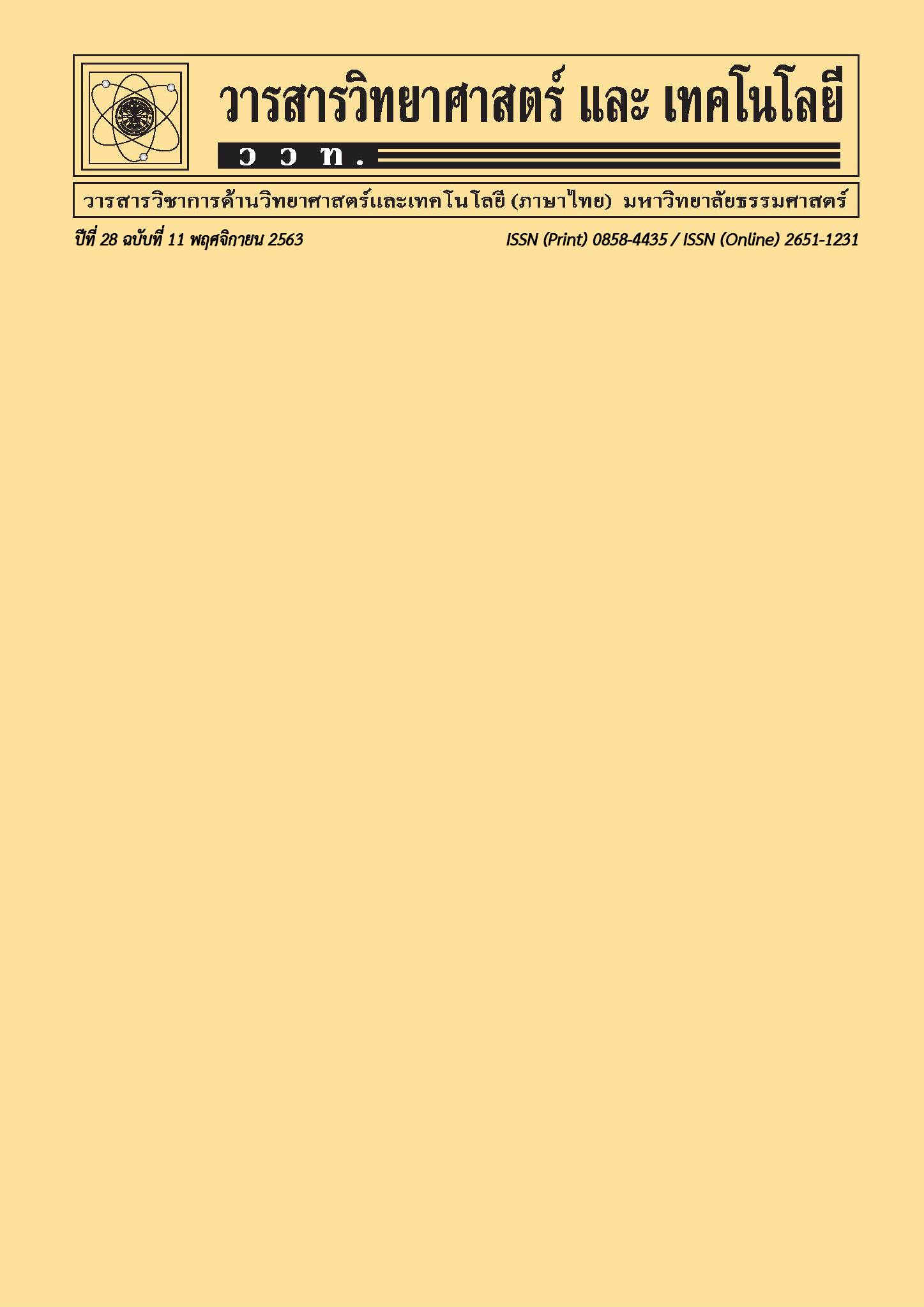ผลของพลาสมาแบบไดอิเล็กทริคแบริเออร์ดิสชาร์จต่อการเจริญเติบโตและปริมาณสารทุติยภูมิของต้นอ่อนผักกาดหอม
Main Article Content
บทคัดย่อ
ศึกษาการเจริญเติบโตและสารทุติยภูมิในต้นอ่อนผักกาดหอม โดยนำเมล็ดพันธุ์ Sweet Green และ Seafresh มาผ่านการฉาย DBD พลาสมา นาน 0, 60 และ 240 วินาที พบว่าการเจริญเติบโตและการสะสมสารทุติยภูมิของต้นอ่อนผักกาดหอมมีการตอบสนองต่อการฉาย DBD พลาสมาต่างกันไปตามพันธุ์และระยะเวลาในการฉายพลาสมา โดยเมล็ดผ่านการฉาย DBD พลาสมา นาน 60 และ 240 วินาที ส่งเสริมการเจริญเติบโตของต้นอ่อนพันธุ์ Sweet Green ซึ่งมีน้ำหนักแห้งเพิ่มขึ้น 18.28 และ 30.11 % ตามลำดับ เมื่อเปรียบเทียบกับการไม่ฉายพลาสมา ส่วนต้นอ่อนพันธุ์ Seafresh จากเมล็ดไม่ผ่านและผ่านการฉาย DBD พลาสมา มีการเจริญเติบโตไม่แตกต่างกันทางสถิติ สารประกอบฟีนอลิกทั้งหมดในต้นอ่อนพันธุ์ Sweet Green จากเมล็ดผ่านการฉาย DBD พลาสมา นาน 240 วินาที มีปริมาณเพิ่มขึ้น 25 % เมื่อเปรียบเทียบกับต้นอ่อนจากเมล็ดไม่ฉายพลาสมา แต่ต้นอ่อนพันธุ์ Seafresh จากเมล็ดที่ฉายและไม่ฉายพลาสมา มีปริมาณสารประกอบฟีนอลิกทั้งหมดไม่แตกต่างกันทางสถิติ สารฟลาโวนอยด์ในต้นอ่อนจากเมล็ดผ่านการฉาย DBD พลาสมา นาน 240 วินาที มีปริมาณเพิ่มขึ้น 8.32 % เมื่อเปรียบเทียบกับต้นอ่อนจากเมล็ดไม่ฉายพลาสมา ต้นอ่อนจากเมล็ดผ่านการฉาย DBD พลาสมาทุกระยะเวลามีฤทธิ์ต้านอนุมูลอิสระ DPPH ดีขึ้น ผลการทดลองจะเห็นได้ว่า DBD พลาสมา เป็นวิธีการหนึ่งที่มีประสิทธิภาพในการกระตุ้นการเจริญเติบโตและเพิ่มปริมาณสารทุติยภูมิของต้นอ่อนผักกาดหอมาดหอม
Article Details
References
Chirokov, A., Gutsol, A. and Fridman A., 2005, Atmospheric pressure plasma of dielectric barrier discharges, Pure Appl. Chem. 77: 487-495.
Moreau, M., Orange, N. and Feuilloley, M. G.J., 2008, Non-thermal plasma techno logy: New tools for biodecontamination, Biotechnol. Adv. 26: 610-617.
Butscher, D., Loon, H.V., Waskov, A., von Rohr, P.R., and Schuppler, M., 2016, Plasma inactivation of microorganisms on sprout seeds in a dielectric barrier discharge, Int. J. Food Microbiol. 238: 222-232.
Štěpánová, V., Slavíček, P., Kelar, J., Prášil, J., Smékal, M., Stupavská, M., Jurmanová, J. and Černák, M., 2018, Atmospheric pressure plasma treatment of agricultural seeds of cucumber (Cucumis sativus L.) and pepper (Capsicum annuum L.) with effect on reduction of diseases and germination improvement, Plasma Process Polym. 15: e1700076.
Ling, L., Jiafeng, J., Jiangang, L., Minchong, S., Xin, H., Hanliang, S. and Yuanhua, D., 2014, Effects of cold plasma treatment on seed germination and seedling growth of soybean, Sci. Rep. 4: 5859.
Ji, S.H., Choi, K.H., Pengkit, A., Im, J.S., Kim, J.S., Kim, Y.H., Park, Y., Hong, E.J., Jung, S.K., Choi, E.H. and Park, G., 2016, Effects of high voltage nanosecond pulsed plasma and micro DBD plasma on seed germination growth development and physiological activities in spinach, Arch. Biochem. Biophys. 605: 117-128.
Singhawiboon, M., Rithichai, P., Jirakaitti kul, Y. and Poolyarat, N., 2018, Effect of dielectric barrier discharge plasma on germination and vigor of lettuce (Lactuca sativa) seed, Thai Sci. Technol. J. 26(5): 815-822. (in Thai)
Iranbakhsh, A., Oraghi Ardebili, Z., Oraghi Ardebili, N., Ghoranneviss, M. and Safari, N., 2018, Cold plasma relieved toxicity signs of nano zinc oxide in Capsicum annuum cayenne via modifying growth, differentiation, and physiology, Acta Physio. Plant. 40: 154.
Dobrin, D., Magureanu M., Mandache, N. B. and Ionita, M.D., 2015, The effect of non-thermal plasma treatment on wheat germination and early growth, Innov. Food Sci. Emerg. 29: 255-260.
Kitazaki, S., Sarinont, T., Kago, K., Hayashi, N. and Shiratani, M., 2014, Plasma induced long-term growth enhancement of Raphanus sativus L. using combinatorial atmospheric air dielectric barrier discharge, Curr. Appl. Phys. 14: 149-153.
Jiafeng, J., Xin, H., Ling, I., Jiangang, L., Hanliang, S., Qilai, X., Renhong, Y. and Yuanhua, D., 2014, Effect of cold plasma treatment on seed germination and growth of wheat, Plasma Sci. Technol. 16: 54-58.
Worawattananutai, P., Itharat, A. and Ruangnoo, S., 2014, In vitro antioxidant, anti-inflammatory, cytotoxic activities against prostate cancer of extracts from Hibiscus sabdariffa leaves, J. Med. Assoc. Thai. 97: 81-87.
Folin, O. and Ciocalteu, V., 1927, On tyrosine and tryptophane determinations in proteins, J. Biol. Chem. 73: 627-650.
Zhu, H., Wang, Y., Liu, Y., Xia, Y. and Tang, T., 2010, Analysis of flavonoids in Portulaca oleracea L. by UV-Vis spectro photometry with comparative study on different extraction technologies, Food Anal. Methods 3: 90-97.
Yamasaki, K., Hashimoto, A., Kokusenya, Y., Miyamoto, T. and Sato, T., 1994, Electrochemical method for estimating the antioxidative effect of methanol feeding, Enzyme Microb. Tech. 36: 133-138.
Šerá, B., Špatenka, P., Šerý, M., Vrchotová, N. and Hrušková, I., 2010, Influence of plasma treatment on wheat and oat germination and early growth, IEEE Trans. Plasma Sci. 38: 2963-2968.
Bußler, S., Herppich, W.B., Neugart, S., Schreiner, M., Ehlbeck, J., Rohn, S. and Schlüter, O., 2015, Impact of cold atmospheric pressure plasma on physiology and flavonol glycoside profile of peas (Pisum sativum ‘Salamanca’), Food Res. Int. 76: 132-141.
Mihai, A.L., Dobrin, D., Măgureanu, M. and Popa, M.E., 2014, Positive effect of non-thermal plasma treatment on radish seeds, Rom. Rep. Phys. 66: 1110-1117.
Matra, K., 2016, Non-thermal plasma for germination enhancement of radish seeds,
Procedia Comput. Sci. 86: 132-135.
da Silva, A.R.M., Fariasa, M.L., da Silva, D.L.S., Vitorianoa, J.O., de Sousab, R.C. and Alves, C.Jr., 2017, Using atmospheric plasma to increase wettability, imbibition and germination of physically dormant seeds of Mimosa caesalpiniafolia, Colloids Surf. B 157: 280-285.
Filatova, I., Azharonok, V., Lushkevich, V., Zhukovsky, A., Gadzhieva, G., Spasić, K., Živković, S., Puač, N., Lazović, S., Malović, G. and Petrović, Z.L., 2013, Plasma seeds treatment as a promising technique for seed germination Improvement, 31st ICPIG, Granada.
Šerá, B., Gajdová, I., Černák, M., Gavril, B., Hnatiuc, E., Kováčik, D., Kříha, V., Sláma, J., Šerý, M. and Špatenka, P., 2012, How various plasma sources may affect seed germination and growth, IEEE Trans. Plasma Sci. 40: 1365-1370.
Iranbakhsh, I., Ghoranneviss, M., Oraghi Ardebili, Z., Oraghi Ardebili, N., Hesami Tackallou, S. and Nikmaram, H., 2017, Non-thermal plasma modified growth and physiology in Triticum aestivum via generated signaling molecules and UV radiation, Biol. Plantarum 61: 702-708.
Rice-Evans, C.A. and Miller, N.J., 1996, Antioxidant activities of flavonoids as bioactive components of food, Biochem. Soc. Trans. 24: 790-795.
Barreca, D., Bellocco, E., Caristi, C., Leuzzi, U. and Gattuso, G., 2011, Distribution of C- and O-glycosyl flavonoids, (3-hydroxy-3-methylglutaryl) glycosyl flavanones and furocoumarins in Citrus aurantium L. juice, Food Chem. 124: 576-582.
Rodglin, C., Srisook, E. and Srisook, K., 2017, Effects of extraction conditions on total phenolic content, total flavonoid content and antioxidant activities of different parts of Citrus aurantium L., Burapha Sci. J. 22(1): 211-225. (in Thai)
Rithichai, P., Khemwichai, P. Jirakiattikul, Y. and Youngvises, N., 2015, Flower development and antioxidant capacity in moonflower (Ipomoea alba L.), Thai Sci. Technol. J. 23(3): 497-506. (in Thai)

